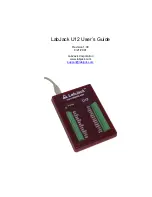
Whether or not the ground (GND) connection is needed (Figure 2-3) will depend on the nature
of Vs.
Figure 2-3. Differential measurement.
Figure 2-4 shows a single-ended connection used to measure the output voltage of a typical
voltage-divider circuit. The voltage divider circuit is a simple way to convert a varying resistance
(thermistor, photoresistor, potentiometer, etc.) to a varying voltage. With nothing connected to
Va, the value of the unknown resistance, R2, can be calculated as:
R2 = Va*R1 / (Vs-Va),
where Vs is the supply voltage (+5V in Figure 2-4).
When Va is connected to AI0, as shown in Figure 2-4, the input bias current of the LabJack
affects the voltage divider circuit, and if the resistance of R1 and R2 is too large, this effect must
be accounted for or eliminated. This is true for any signal with too high of a source impedance.
All measuring devices have maximum analog input bias currents that very from picoamps to
milliamps. The input bias current of the LabJack U12’s analog inputs varies from +70 to -94
microamps (
µ
A). This is similar to an input impedance of about 100 k
Ω
, but because the current
is nonzero at 0 volts, it is better to model the analog input as a current sink obeying the following
rule:
Iin = 8.181*Va – 11.67
µ
A
Figure 2-4. Single-ended measurement with voltage divider circuit.
























